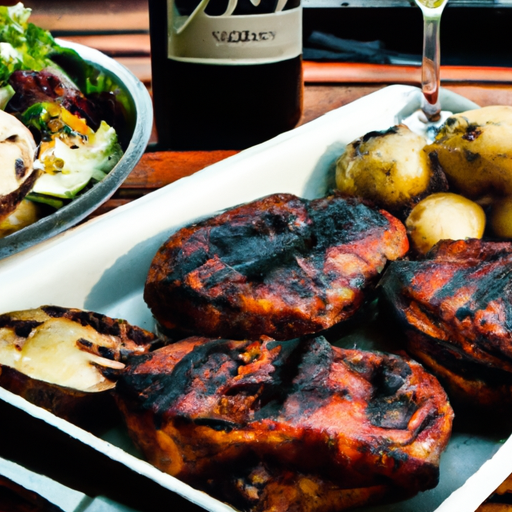Picture yourself sitting in a charming restaurant nestled in the heart of Argentina. The tantalizing aroma of sizzling meat fills the air, as you eagerly anticipate the arrival of your perfectly cooked asado. Crispy empanadas, bursting with flavor, await to be devoured. And what better way to complement these delectable dishes than with a glass of rich and velvety Malbec wine? In this flavorful journey, Tastepan.com invites you to explore the vibrant food culture and traditions of Argentina. Through sumptuous asado, mouthwatering empanadas, and the seductive allure of Malbec, prepare to embark on an unforgettable culinary experience that will transport your taste buds to the heart and soul of Argentina.

Traditional Argentine Cuisine
Argentina is known for its rich culinary heritage, which is deeply rooted in its history and influenced by various cultures. Traditional Argentine cuisine combines indigenous ingredients with the culinary traditions brought by European immigrants, resulting in a unique and flavorful gastronomy. From the mouthwatering barbecue known as Asado to the delectable sweet treats such as Alfajores, Argentine cuisine is a celebration of diverse flavors.
Historical Influences
The history of Argentine cuisine is shaped by the fusion of indigenous ingredients and the culinary traditions of European immigrants. The native indigenous people, such as the Mapuche and Guarani, cultivated maize, potatoes, and quinoa, which became staple ingredients in the Argentine diet. When the Spanish colonizers arrived in the 16th century, they introduced livestock, such as cattle and sheep, which eventually became central to Argentine gastronomy.
Regional Variations
Argentina is a vast country with diverse landscapes and climates, and as a result, different regions have their own culinary specialties. In the northwest region, influenced by indigenous traditions, dishes like humitas (steamed corn cakes) and locro (a hearty meat and corn stew) take center stage. In the central region, where the capital city of Buenos Aires is located, the culinary scene is characterized by hearty meat dishes, indulgent pastries, and Italian-inspired cuisine. The coastal regions, on the other hand, boast an abundance of fresh seafood and shellfish, which are used in dishes like paella and seafood empanadas.
Key Ingredients
Several ingredients play a crucial role in traditional Argentine cuisine. As a country known for its high-quality beef, meat takes a prominent place on Argentine tables. Grass-fed beef, known for its tenderness and flavor, is a cornerstone of Argentine cuisine and is often enjoyed in the form of succulent steaks or slow-roasted on the grill as part of an Asado. Other popular meats include pork, lamb, and chicken, which are used in a variety of traditional dishes.
Yerba mate, a traditional herbal tea, is another key ingredient in Argentine gastronomy. Prepared by steeping dried leaves of the yerba mate plant in hot water, mate is not only a beverage but also a social and cultural experience shared among friends and family. It is often served in a hollowed-out gourd with a metal straw called a bombilla.
Asado: The Quintessential Argentine BBQ
Argentine Asado is more than just a meal; it is a cultural institution and a cherished tradition. Originating from the gauchos, or Argentine cowboys, Asado is a social event that brings people together to enjoy the art of grilling meat over an open fire.
Origin and Significance
Asado has its roots in the gaucho culture, which emerged in the vast grasslands of the Pampas region. Gauchos would gather around a fire, known as a fogón, and cook meat on a grill called a parrilla. This communal style of cooking and sharing food became a quintessential part of Argentine culture and is cherished by families and friends to this day.
Preparation and Cooking Techniques
The preparation of an Asado begins with selecting the finest cuts of meat, such as beef ribs, flank steak, sausages, and morcilla (blood sausage). The meat is marinated in a simple mixture of salt, pepper, and sometimes, chimichurri sauce, which adds additional flavor. Once the meat is marinated, it is carefully placed on the grill and cooked slowly over the glowing embers of a wood fire. The slow cooking process allows the meat to develop a delicious smoky flavor and achieve a perfect balance of tenderness and juiciness.
Popular Cuts of Meat
In an Argentine Asado, various cuts of meat are showcased and enjoyed. Bife de chorizo, a thick sirloin steak, is one of the most popular cuts and is known for its rich marbling and intense flavor. Costillas, or beef ribs, are another beloved cut, offering a succulent and tender meaty experience. Vacío, a flavorful flank steak, and morcilla, a blood sausage made with herbs and spices, are also commonly served during an Asado. No matter the cut, each piece of meat is carefully cooked to perfection and savored with delight.

Empanadas: Savory Pocket Pies
Empanadas are a beloved staple of Argentine cuisine, enjoyed as a snack, appetizer, or even a full meal. These savory pocket pies are a testament to the culinary influence of Spanish and Italian immigrants, who brought their own versions of the dish to Argentina.
History and Cultural Importance
The history of empanadas can be traced back to medieval Spain, where they were first made. These portable pastries were carried by soldiers during wars and subsequently spread across the Spanish Empire. When the Spanish settlers arrived in Argentina, they brought their empanada-making skills and influenced the local cuisine. Over time, empanadas became deeply embedded in Argentine culture and gained regional variations and fillings.
Common Fillings
Empanadas can be filled with a variety of ingredients, both savory and sweet. In Argentina, the most traditional filling is known as carne, which consists of ground beef, onions, and spices. Other popular savory fillings include chicken, ham and cheese, spinach and ricotta, and corn. For those with a sweet tooth, empanadas de dulce de leche, filled with Argentina’s beloved caramel-like spread, are a delicious option.
Variations by Region
Just like many dishes in Argentina, empanadas vary from region to region, each with its own distinct characteristics. In the northern provinces, empanadas are often wrapped in yucca or corn dough and are typically spicier. In the central region, where Buenos Aires is located, the typical empanada dough is made with wheat flour and lard, resulting in a flaky and buttery crust. In the southern region of Patagonia, empanadas are traditionally made with lamb or seafood fillings, reflecting the availability of these ingredients in the area. No matter the region, empanadas are a beloved snack enjoyed by all.

Mate: Argentina’s Beloved Herbal Beverage
Mate, Argentina’s national beverage, is more than just a drink; it is a cultural symbol and a way of life. This traditional herbal beverage is deeply ingrained in Argentine society and holds immense social and cultural significance.
Origin and Tradition
The origins of mate can be traced back to the indigenous Guarani people of South America, who discovered the rejuvenating properties of the yerba mate plant. The Guarani used the leaves of the plant to brew a tea-like drink, which they believed had medicinal and spiritual qualities. When the Spanish colonizers arrived in the 16th century, mate drinking was adopted by the European settlers and became an integral part of Argentine culture.
Preparing and Serving Mate
Preparing mate requires a special set of tools, including a dried gourd, a bombilla (a metal straw with a filter), and loose yerba mate leaves. The gourd is filled with the yerba mate leaves, and hot water is poured over the leaves. The bombilla is then inserted into the gourd, allowing the drinker to sip the infused liquid through the straw while the leaves remain in the gourd.
Mate is traditionally passed around among a group of friends or family members, with each person taking turns and sipping from the same gourd. This ritual of sharing mate fosters a sense of unity and companionship.
Social and Cultural Significance
Mate is not just a beverage; it is a way of connecting with others and building strong relationships. Sharing mate is a common social activity in Argentina, often enjoyed during gatherings, intimate conversations, or even work breaks. It brings people together, fostering a sense of community and friendship. Mate is also deeply embedded in daily routines and is often enjoyed in the morning, afternoon, and evening.
The Taste Of Argentina: Asado, Empanadas, And Malbec Here are some content to give your more context about the subject: Dive into the diverse world of food culture and traditions with Tastepan.com. Explore culinary histories, regional cuisines, and food-related stories that will deepen your appreciation for the global tapestry of flavors. Immerse yourself in the rich heritage of food. The Taste of Argentina: Asado, Empanadas, and Malbec.

